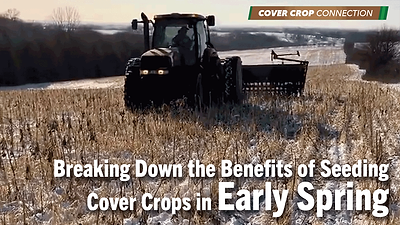By John Dobberstein, Senior Editor
Data from the 2nd annual Cover Crop Benchmark Study — compiled and organized by Cover Crop Strategies — shows a proposed rule change to NRCS conservation technical standards relating to cover crops could have a very negative affect on farmers and ranchers.
The proposed change would prohibit farmers from mechanically harvesting cover crops for hay or silage, potentially causing some headaches for no-tillers who rely on covers as an option to feed livestock or raise their own cover crop seed.
Changes to the agency’s Conservation Practice Standards were published March 9 and a month was set aside for comment. The deadline was later extended to April 22. The group of revisions has drawn more than 100 comments, including numerous complaints from growers, agronomists, professors, seed industry reps and lawmakers.
Options Being Reduced
Nearly 40% of the Cover Crop Benchmark Study respondents said they baled cover crops for livestock feed in 2020, up from 32% in 2019, according to the Benchmark Study — an industry exclusive survey of growers compiled by Cover Crop Strategies.
Another potential issue is that many growers raise and harvest their own cover crop seed to reduce the expense. Some 17.4% of farmers responding raised their own cover crop seed in 2020, compared to 24.4% in 2019. Another 19% of farmers sourced their seed from neighbors or area farmers, up from 16% the year before.
In 2020, responding farmers ranked “cost of seed” as the second-biggest management challenge they have with cover crops, up from the third-biggest in 2019.
Nearly 20% of farmers paid $30 an acre or more for cover crop seed in 2020 — up 4 points from the prior year — and almost 6% paid $40 an acre or more. Approximately 80% paid $29 per acre or less.
In 2019 and 2020, only 49% of farmers were accepting federal, state or local incentive payments to raise cover crops, meaning they had to foot most of the cost themselves.
Protests Continue
Recently, crop protection company Syngenta, the Iowa Corn Growers Assn., West Virginia Department of Agriculture and Northeast Organic Farming Assn., submitted comments criticizing the rule change. Many farmers are also against the changes.
Mike Wolpert, a long-time no-tiller from Buffalo, W.V., has extensively used cover crops for 10 years and although he doesn’t normally harvest them, wet conditions of late has caused grain seeding failures. He’s also concerned the rule change could affect cover crop adoption.
“Allowing harvest of the excess cover crop allows successful seeding of the grain crop,” he says. “I have neighbors with livestock who depend on the practice for an important part of their forage program.”
Even though cover crops provide a major benefit by reducing runoff of soil and nutrients into watersheds, harvesting them doesn’t affect water quality issues, he adds. “By the time of harvest, the cover has protected the ground and the stubble and roots protect the surface on nearly all slopes.”
Syngenta supports some changes the agency is making to CPS 340, but the company says it has “serious concerns” with disallowing mechanical harvesting of cover crops for forage.
“As written, this provision represents a significant disincentive to grower adoption of cover crops and could impact working lands’ conservation benefits,” the company says. “For many of the same reasons that some producers graze their cover crops, many also mechanically harvest a portion of them for forage and seed for replanting and are able do so without diminishing their conservation benefits.
“In both instances, the uses of the forage and seed are supplementary to the producers’ conservation and environmental goals from this practice. There is no science-based rationale for disallowing mechanical harvesting.”
Five members of New York’s Congressional delegation penned a letter to NRCS Acting Chief Terry Cosby on April 8 protesting the decision and asking the agency to continue to allow harvesting practices.
“Our producers rely heavily on cover crops to control soil erosion and utilize the crops as a feed source for their animals,” wrote U.S. representatives Elise Stefanik, Chris Jacobs, Claudia Tenney, Antonio Delgado and Sean Patrick Maloney.
The Next Steps
The NRCS says the next step is for review of the comments, follow-up discussions with agency leadership and discussion with the national discipline leads and technical specialists.
Betsy Dierberger, a national agronomist for the NRCS, says the Federal Register comments are “key to understanding the needs of the public. Consideration of the comments is a critical step in our process of conservation practice standard revision. A CPS is not final until the comments are considered and adjustments are made as needed.”
Timelines could change, but Dierberger says review and response to the comments may be completed by July and revisions to the CPS Cover Crop guidelines would follow with completion anticipated by the end of the year.
The 2018 Farm Bill required NRCS to review all 169 existing national conservation practices to seek opportunities to “increase flexibility and incorporate new technologies to help the nation’s farmers, ranchers, and private forest landowners better protect natural resources on their working lands.”
In 2020, 57 conservation practice standards were updated after public review and are available on nrcs.usda.gov. NRCS’s conservation practices offer guidelines for planning, installing, operating and maintaining conservation practices nationwide.
As it pertains to cover crops, the new guidelines suggested cover crops can be grazed, but not “mechanically harvested for seed, hay, silage or other biomass.”



